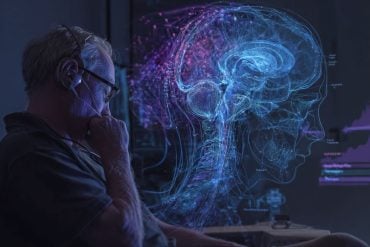Summary: Donepezil, a drug routinely administered to slow cognitive decline in Alzheimer’s disease, shows promise in treating damage caused to the brain by adolescent alcohol exposure. The drug reverses neuroinflammation and neuron damage in rats exposed to alcohol during adolescence.
Source: Duke University Medical Center
A drug used to slow cognitive decline in adults with Alzheimer’s disease appears to reverse brain inflammation and neuron damage in rats exposed to alcohol during adolescence.
In a study described in the journal Scientific Reports, Duke Health researchers sought to understand how intermittent binge drinking changes the hippocampus — a region long known to be critical for learning and memory, and also linked to anxiety — and whether the drug, donepezil, could reverse those changes. Rats were used as a model for teens and young adults who binge drink a few times a week.
“Research has begun to show that human adolescents who drink early and consistently across the adolescent years have some deficits in brain function that can affect learning and memory, as well as anxiety and social behaviors,” said senior author Scott Swartzwelder, Ph.D., professor of psychiatry at Duke.
“The changes can be subtle, but who wants even subtle deficits in their brain function or how they think and feel?” Swartzwelder said. “Studies in animal models show that adolescent alcohol exposure can change the ways nerve cells communicate with each other, and the level of plasticity in brain circuits — compromising the ability of the brain to change and adapt. These changes can be seen in adulthood – long after alcohol exposure has ended”
Because they can’t ethically have young people drink alcohol to study its effects, researchers use the developing brains of rats to understand the effects of “intermittent alcohol exposure,” resulting in blood-alcohol levels that are consistent with those achieved by human adolescent drinkers.
The scientists observed that in addition to brain inflammation, adolescent alcohol exposure inhibited the birth of new neurons in the hippocampus, Swartzwelder said, and may even accelerate neuronal death — making it is easier to lose existing cells and more difficult to produce new ones.
Once the rats reached adulthood, they were given donepezil, a cognition-enhancing drug that is marketed under the brand name Aricept. After four days of treatment, the researchers studied the animals’ brains, looking closely at the hippocampus. The rats that received donepezil in adulthood after adolescent alcohol exposure showed less inflammation and better ability to produce new neurons compared to rats that did not receive the donepezil treatment.
“We don’t know if the reversal of these alcohol effects by donepezil is permanent, but it at least transiently reverses them,” Swartzwelder said.
Swartzwelder said the study helps clarify the subtle health risk of heavy drinking among young adults, which has been difficult to ascertain.

“It’s obvious that not everyone who drinks during adolescence grows up and completely fails at life,” Swartzwelder said. “You might not notice the deficits in obvious ways every day, but you run the risk of losing your edge. Sometimes a small impairment of brain function can have a broad ripple effect in someone’s life.”
Importantly, the research demonstrates the potential to repair some types of damage caused by adolescent alcohol exposure, he said. But beyond that, it could also lead to a more specific understanding of the cellular mechanisms that make the developing brain particularly vulnerable to substances such as alcohol.
Funding: The research was part of the Neurobiology of Adolescent Drinking in Adulthood (NADIA) Consortium and was supported by the National Institute on Alcohol Abuse and Alcoholism and the National Institutes of Health (2U01AA019925, P60 AA011605, U01 AA020023, U24 AA020024, U54 AA019767).
In addition to Swartzwelder, study authors included Kati L. Healey, Wen Liu, Kira Dubester, Kelsey M. Miller and Fulton T. Crews.
Source:
Duke University Medicial Center
Media Contacts:
Sarah Avery – Duke University Medical Center
Image Source:
The image is in the public domain.
Original Research: Open access
“Changes in Neuroimmune and Neuronal Death Markers after Adolescent Alcohol Exposure in Rats are Reversed by Donepezile”. H. S. Swartzwelder, Kati L. Healey, Wen Liu, Kira Dubester, Kelsey M. Miller & Fulton T. Crews.
Scientific Reports. doi:10.1038/s41598-019-47039-1
Abstract
Changes in Neuroimmune and Neuronal Death Markers after Adolescent Alcohol Exposure in Rats are Reversed by Donepezil
Adolescent intermittent ethanol (AIE) exposure diminishes neurogenesis and dendritic spine density in the dentate gyrus. The cholinesterase inhibitor, donepezil (Aricept), reverses AIE effects on dendritic spines, possibly by interacting with inflammatory and/or epigenetic mediators after AIE exposure. This study tests the hypothesis that donepezil reverses AIE-induced neuroimmune, and epigenetic changes in the adult dentate gyrus. Adolescent Sprague-Dawley male rats (PD30-43) were given 10 intermittent, intragastric doses of ethanol (5.0 g/kg) or isovolumetric water (AIW). Twenty-one days later half of the animals from each group were treated with either donepezil or isovolumetric water (i.g.) once daily for four days. Two hours after the last donepezil or water dose animals were sacrificed and brains prepared for immunohistochemical analyses. AIE reduced immunoreactivity for doublecortin (DCX) and increased immunoreactivity for activated caspase-3 and death receptor-3 in adulthood, suggesting an enduring attenuation of neurogenesis and an increase in progenitor death. These effects were reversed by donepezil treatment in adulthood. AIE also increased immunoreactivity for the inflammatory signaling molecules HMGB1 and RAGE, as well as the activated phosphorylated transcription factor pNFκB p65, and the gene silencing marker dimethylated histone H3K9. All of these AIE effects were also reversed by donepezil, with the exception of HMGB1.






